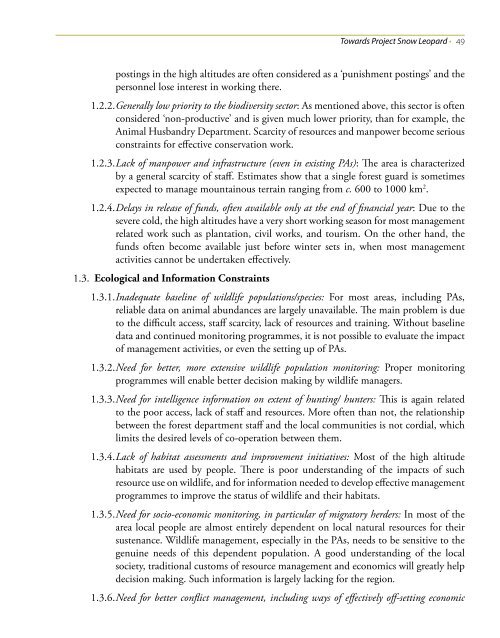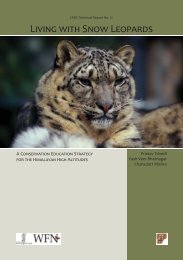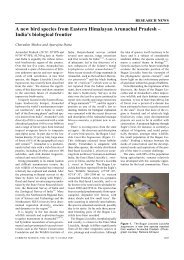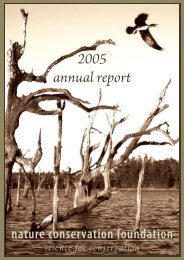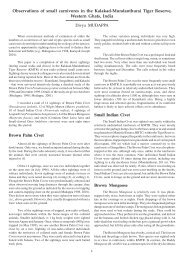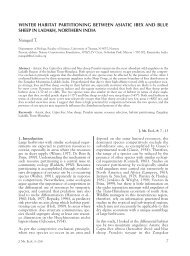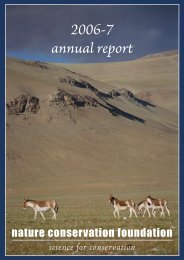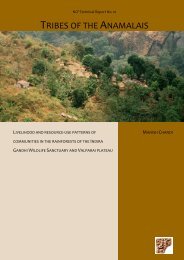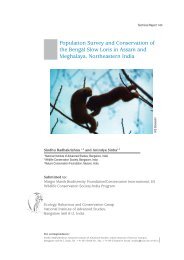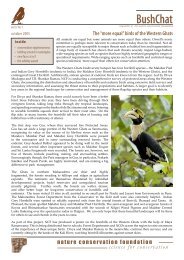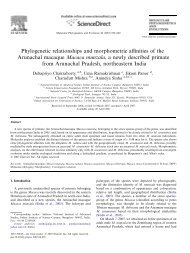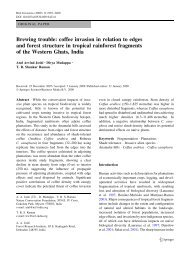towards project snow leopard - Nature Conservation Foundation
towards project snow leopard - Nature Conservation Foundation
towards project snow leopard - Nature Conservation Foundation
Create successful ePaper yourself
Turn your PDF publications into a flip-book with our unique Google optimized e-Paper software.
Towards Project Snow Leopard • 49<br />
postings in the high altitudes are often considered as a ‘punishment postings’ and the<br />
personnel lose interest in working there.<br />
1.2.2. Generally low priority to the biodiversity sector: As mentioned above, this sector is often<br />
considered ‘non-productive’ and is given much lower priority, than for example, the<br />
Animal Husbandry Department. Scarcity of resources and manpower become serious<br />
constraints for effective conservation work.<br />
1.2.3. Lack of manpower and infrastructure (even in existing PAs): The area is characterized<br />
by a general scarcity of staff. Estimates show that a single forest guard is sometimes<br />
expected to manage mountainous terrain ranging from c. 600 to 1000 km 2 .<br />
1.2.4. Delays in release of funds, often available only at the end of financial year: Due to the<br />
severe cold, the high altitudes have a very short working season for most management<br />
related work such as plantation, civil works, and tourism. On the other hand, the<br />
funds often become available just before winter sets in, when most management<br />
activities cannot be undertaken effectively.<br />
1.3. Ecological and Information Constraints<br />
1.3.1. Inadequate baseline of wildlife populations/species: For most areas, including PAs,<br />
reliable data on animal abundances are largely unavailable. The main problem is due<br />
to the difficult access, staff scarcity, lack of resources and training. Without baseline<br />
data and continued monitoring programmes, it is not possible to evaluate the impact<br />
of management activities, or even the setting up of PAs.<br />
1.3.2. Need for better, more extensive wildlife population monitoring: Proper monitoring<br />
programmes will enable better decision making by wildlife managers.<br />
1.3.3. Need for intelligence information on extent of hunting/ hunters: This is again related<br />
to the poor access, lack of staff and resources. More often than not, the relationship<br />
between the forest department staff and the local communities is not cordial, which<br />
limits the desired levels of co-operation between them.<br />
1.3.4. Lack of habitat assessments and improvement initiatives: Most of the high altitude<br />
habitats are used by people. There is poor understanding of the impacts of such<br />
resource use on wildlife, and for information needed to develop effective management<br />
programmes to improve the status of wildlife and their habitats.<br />
1.3.5. Need for socio-economic monitoring, in particular of migratory herders: In most of the<br />
area local people are almost entirely dependent on local natural resources for their<br />
sustenance. Wildlife management, especially in the PAs, needs to be sensitive to the<br />
genuine needs of this dependent population. A good understanding of the local<br />
society, traditional customs of resource management and economics will greatly help<br />
decision making. Such information is largely lacking for the region.<br />
1.3.6. Need for better conflict management, including ways of effectively off-setting economic


